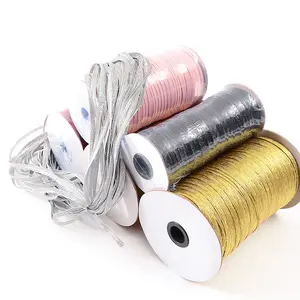(452 products available)










































































































































































































Mask elastic strings are thin, flexible cords or strings made of elastic material, typically used to secure a mask comfortably around the ears or head. These strings enable the mask to fit snugly to the wearer's face, creating a barrier against particles, pollutants, or pathogens. They are essential components of masks, facilitating easy on and off while ensuring a secure fit. The quality and stretchability of mask elastic strings significantly impact the overall comfort and effectiveness of the mask.
Round Elastic String
These types of mask elastic strings are commonly used due to their versatility and availability. They are made from rubber or latex cores with polyester or nylon coverings. These strings are durable, providing a consistent stretch that helps masks fit securely without causing discomfort. Their round shape ensures an even distribution of pressure, making them a popular choice for various masks, including surgical and cloth masks.
Flat Elastic String
These strings are another widely used type. They are made from a blend of rubber and synthetic fibers, offering excellent stretch and recovery properties. Flat elastic strings are particularly suitable for masks that require a snug fit, such as N95 respirators. Their flat profile sits comfortably against the skin, reducing the likelihood of irritation. They are often used in masks with multiple layers or those designed for extended wear.
Spandex or Lycra Strings
These are known for their exceptional elasticity. These materials can stretch up to six times their original length and return to their normal size without deformation. Spandex or Lycra strings are ideal for masks that require adjustable fittings, such as those with toggles or sliders. They allow for a customizable fit that accommodates various face shapes and sizes. These strings are commonly used in sports and medical masks due to their ability to provide a secure yet flexible fit.
Cotton-Blend Elastic Strings
These are becoming increasingly popular, especially for homemade or cloth masks. They combine the comfort of cotton with the stretchability of synthetic fibers like polyester or nylon. These strings offer a soft feel against the skin, making them suitable for prolonged use. They are available in various colors and thicknesses, allowing for customization to match different mask designs. Cotton-blend elastic strings are also washable and reusable, making them a sustainable choice for mask-making.
The following ideas will help users of masks to enhance their general appearance.
Color Coordination
Users should select colors that complement each other. For instance, black mask elastic strings will fit well with a black or dark-colored mask. The rest of the outfit should match the color of the mask. This helps to achieve a neutral look. It also helps the wearer blend with the environment. In contrast, white or light-colored strings go well with bright or pastel masks. They also match light-colored clothing. This combination gives a fresh and clean appearance. Red strings can match a red mask or accent colors in one's outfit. They add a touch of boldness and flair. Blue strings pair with blue masks and can complement denim or other blue tones. This pairing offers a calm and cohesive look.
Material Match
Matching the material of the elastic strings with that of the mask is crucial. It ensures comfort and functionality. Cotton strings work well with cotton masks. They provide breathability and softness. This combination is suitable for daily use. Silicone strings are versatile. They are ideal for both surgical and homemade masks. They offer adjustability and durability. This match is perfect for long-term wear. Polyester strings are strong and elastic. They pair with polyester or nylon masks. This pairing is great for outdoor activities. Leather strings add a touch of elegance. They match leather or fabric masks. This combination is ideal for a formal look.
Pattern and Design
White mask elastic strings tend to match well with masks that have a white or light base color. They also complement other light-colored clothing. Black strings pair with dark or monochrome masks. They match with dark or neutral outfits too. Red elastic strings can enhance masks of the same color or any mask that has red accents. They match with red or contrasting clothing to create a bold statement. Blue strings usually match masks that are blue or have blue patterns. They also go well with other shades of blue for a coordinated look.
Functionality and Comfort
Polyester and nylon elastic strings are strong and stretchable. They fit well and hold masks securely. Cotton strings are soft and comfortable. They are suitable for sensitive skin. Silicone strings are adjustable and versatile. They are great for different face shapes. Leather strings are stylish and durable. They add a touch of elegance and are suitable for well-designed masks.
Q1: What are the elastic strings used for masks made of?
A1: The strings are made of various materials, but the most common are polyester and rubber or latex. Some strings are made of cotton-elastic material to provide comfort and avoid irritation.
Q2: How long should the strings be cut for a mask?
A2: The length of the strings depends on the type of mask and the fit desired. Generally, 2 ear strings should be 20-25cm long, while 1 head string should be about 40-50cm long.
Q3: Are the elastic strings for masks reusable?
A3: Yes, they are reusable unless they are damaged or lose their elasticity. However, it is essential to clean the strings properly to remove any contaminants they may have acquired from the environment.
Q4: Can the elastic strings be adjusted?
A4: Some elastic strings are adjustable, especially those used for surgical masks. Adjusters can be added to homemade masks to allow for easy adjustment of the strings.
Q5: Can the strings be dyed or customized in color?
A5: Yes, the strings can be dyed using fabric dye or customized directly from the manufacturers. However, it is necessary to select a dye that will not affect the elasticity of the string.